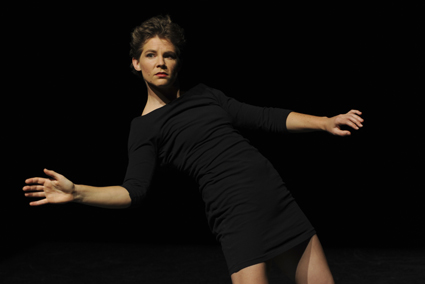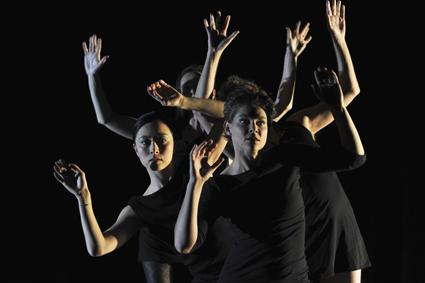Dress sense
Virginia Baxter: Martin Del Amo, Little Black Dress Suite

Miranda Wheen, Quest from Little Black Dress Suite
photo Heidrun Löhr
Miranda Wheen, Quest from Little Black Dress Suite
This suite of dances takes the little black dress as its unifying concept and further asks the question “what happens when you remove an iconic piece of clothing widely associated with feminine elegance and cocktail party glamour from its familiar fashion context?” (program). Running with the choreographer’s premise, I wondered how as an audience we might assess the performance on those terms?
T-dress, V-dress, vintage bandeau, slimline, full-skirted, reverse wrap, Audrey style, whatever, I know that the trick with the LBD is simply to wear it well. Here Martin del Amo is the tailor and each of the dancers adds her/his own personality to the outfit to bring off the elegant display.
In QUEST, Miranda Wheen’s boat-necked, scoop-backed, stretchy number suggests nakedness beneath. The dress slips in response to her movement and we note the changing ratio of cloth to skin. As she moves outside the light, the space she’s tentatively exploring envelops her in its own dark materials. Wheen’s dance is all weight shifts and balances as she slowly negotiates a path at first vertical, then horizontal. With the body at full stretch, the fabric moves as the dancer tests her limbs. Working in tandem with Alex Pozniak’s edgy score, her initial expression of someone driven also suggests a struggle with the elements. Only momentarily ungainly without her shoes, Wheen remains able-bodied, the garment largely compliant. Only when she returns to the place she began, equilibrium restored, do we notice the trickle of sweat running down the back of her dress.
Martin del Amo in What Good Is Sitting Alone In Your Room chooses for himself a no fuss, short, sleeveless black shirt-waist and soft lace-up boots. He’s simply dressed for action confidently expressed in the form of smoothly articulated arms, legs, hips, spins and Bob Fosse-style poses sideways and front-on. Who needs black hats and high kicks? His appearance is showy enough with no evidence of sweat to dispel the stylish impression. Gail Priest’s chiming minimalism from her album Presentiments from the Spider Garden weaves its own spell here.
In Tomorrow never comes Kristina Chan, elegant in a sleeveless A-line shift, black pumps, earrings, nails polished pink, might be exploring the same abstract territory as Miranda Wheen but within a much tighter frame. Again, arms reach outwards and balance on air. Not a hair out of place, her body appears to float, leaning close to off-balance until once more regaining its perfect poise while the sublime voice of Kiri Te Kanawa soars in unison.
In A Certain Slant of Light, Sue Healey in dramatic cowl neckline, patterned stockings, serious boots and with Arvo Part for company, feels her way through the space, breaking into sweeping moves and turns, deft spins and enclosing gestures. Like each of the dancers, Healey expresses a high level of concentration—there’s a sense that every move is being internally analysed as it’s being executed, an element of showing and simultaneously meditating on the movement.

Little Black Dress Suite
photo Heidrun Löhr
Little Black Dress Suite
Finally all four dancers join in a careful pattern of slow, weaving movements in and around each other in a narrow horizontal plane to the aptly haunting song “Like An Angel Passing Through My Room.” In the end, like the iconic dress, it’s all about line and grace and these dancers, each in their own idiosyncratic way, appear to have that sewn up, carrying off the choreographer’s premise with aplomb.
FORM Dance Projects and Riverside: Little Black Dress Suite, choreographer-director Martin del Amo, performers Miranda Wheen, Kristina Chan, Sue Healey, Martin del Amo; Lennox Theatre, Riverside Theatres, Parramatta, 15-17 August, 2013
See our also our In Profile feature on Miranda Wheen
RealTime issue #117 Oct-Nov 2013 pg. 20






